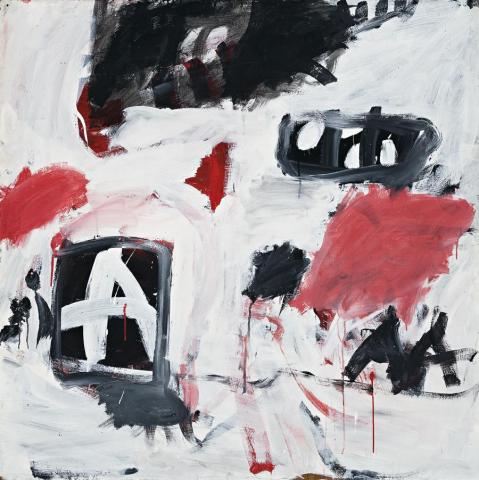RED BLACK AND WHITE NO 1 (LETTER "A"), 1964
Tony Tuckson
synthetic polymer paint on composition board
122.0 x 122.0 cm
inscribed verso: T TUCKSON WATTERS ‘75
inscribed verso: To. Dr Clive Jones /9 Smith St Fitzroy
Watters Gallery, Sydney
Deutscher Fine Art, Melbourne
Collection Ian and Clive Jones, Melbourne
Kalli Rolfe Contemporary Art, Melbourne
Private company collection, Melbourne
Tony Tuckson '62 – 65', Watters Gallery, Sydney, 1975
When Tony Tuckson died at the tragically early age of fifty-two, he left behind many monumental achievements. In the field of curatorship there is the outstanding collection of Australian Aboriginal and Melanesian art at the Art Gallery of New South Wales - for the first time presented as art and not artefacts of ethnography. Then followed the wonderful 1972 interiors of that same gallery - the finest of any in this country - the result of the creative interaction between Tuckson and the gifted architect, Andrew Andersons. The professionalism and collegiality of the staff at the Sydney gallery is another of Tuckson's benefactions. Above all is his body of paintings and drawings, some of which had their public presentation during his lifetime in shows at Watters Gallery in 1970 and 1973. Tuckson brought to his art those same high qualities he showed in leadership, administration and as curator and Deputy Director of the Art Gallery of New South Wales. Drawing upon his rich experiences in the arts, some people have seen his art as an expression of Australia's multiculturalism. Loquacious in other areas, he seldom spoke and never wrote about his own art. Our knowledge is derived from conversations with friends and his writings on Aboriginal art, especially his contribution to the book, Australian Aboriginal Art published in 1964, close in time to our painting. His observations applied equally to his own painting. Art- 'is subjective, symbolic, based on knowledge rather than visual appearances.'1 Stating that 'Content and form are fused by the intuitive processes of the artist', Tuckson cautioned that 'To appreciate fully any work of art, we must use the same sense of intuition as the artist, together with our own conscious knowledge of other works of art, in order to judge quality.'2
Tuckson's red, black and white series of paintings of the early sixties are among his best works. They are innovative, dramatic, and aggressive. In reflection, Sandra McGrath wrote of their '...sense of inner tension that is checked and restrained. They are turgid and moody and represent some of the toughest but most difficult work of his career. Much too complete to be called transitional - they nevertheless exude a sense of unexploded energy and passion.'3 In his tribute to Tuckson, Daniel Thomas described him as 'an Abstract Expressionist of world quality', and 'one of Australia's best painters.'4 Many have noted that his art is all about the act of painting and the feelings involved. There is that further fascination of the symbolism that stalks his paintings and the challenges and seductive involvements its interpretation presents.
1. Tuckson, J. A., 'Aboriginal Art and the Western World', Australian Aboriginal Art, Ure Smith, Sydney, 1964, p. 64, quoted in McGrath, S., 'Tony Tuckson', Art and Australia, Sydney, vol. 12, no. 2, October - December 1974, p. 164
2. ibid, quoted in Thomas, D. R., 'An Introduction to Tony Tuckson, 1921 - 1973, Thomas, D., Free, R., Legge, G., Tony Tuckson, Craftsman House, Sydney, 1989, p. 28
3. McGrath, op. cit., p. 165
4. Thomas, D. R., 'Tony Tuckson - an appreciation', Art and Australia, Sydney, vol. 11, no. 3, January " March 1974, p. 236c
DAVID THOMAS
